August 2022 Regulatory Update
The Rhode Island Governor has signed the law which restricts per- and polyfluoroalkyl substances (PFAS) in food packaging. The prohibition of PFAS will become effective on 1 January 2024.
View Story Read MoreOn 29 June 2022, the Rhode Island Governor signed bill HB 7438 (SB 2044), amending the State’s "Toxic Packaging Reduction Act" (TPRA). This bill regulates food packaging containing Perfluoroalkyl and polyfluoroalkyl substances (PFAS) that have been intentionally added in any amount from being manufactured, knowingly sold, or distributed in Rhode Island. The ban will go into effect on 1 January 2024.
"PFAS chemicals" are defined by the law as all members of the class of fluorinated organic chemicals containing at least one fully fluorinated carbon atom. "Food packaging" is defined as any package or packaging component that is applied to, or in direct contact with, any food or beverage.
The new law amends Sections 23-18.13-2, 23-18.13-3 and 23-18.13-4 to the state’s TPRA under Chapter 23-18.13. The TPRA originally only included requirements for lead, mercury, cadmium, and hexavalent chromium in all packaging. The amendment adds PFAS to the law, however the PFAS requirements are limited to just food packaging. The law also bans any substitute intended to replace any of the chemicals regulated which would create a hazard as great as, or greater than, the hazard of the chemicals regulated.
Highlights of the new law on PFAS in food packaging and the existing law on heavy metals in packages or packaging components are summarized in Table 1.
| Substances | Scope | Requirement | Effective Date |
| PFAS | Food packaging | Prohibited if intentionally introduced | 1 January 2024 |
| Lead, cadmium, mercury, hexavalent chromium | Package or packaging component | ≤ 100 ppm (sum of 4 metals) | In force |
On 11 June 2022, Health Canada published a proposal, Canada Gazette, Part 1, Volume 156, Number 24: Carriages and Stroller Regulations to replace and repeal Carriage and Stroller Regulations (SOR/2016-167). This change is to align to international standards.
The public comment period was open until 20 August 2022.
View Story Read MoreThe regulatory proposal, Canada Gazette, Part 1, Volume 156, Number 24: Carriages and Stroller Regulations, addresses five types of requirements for carriages and strollers. Specifics are as follows:
- Mechanical requirements (align to ASTM F833 and ISO 31110)
There are 22 changes,
- Product and accessory definitions: introduce and update terminology to account for new designs of carriages, strollers, and accessories and to align with other jurisdictions, where appropriate.
- Sharp parts and surfaces: Amend the requirements and test method for sharp edges, corners, points, projections, burrs, and cracks and for smooth finish.
- Small parts choking hazard: Amend the requirements and test method for small parts by adding the torque test method to test for the removal of protective components.
- Latching system integrity: Amend the requirements and test method to evaluate the structural integrity of the latching mechanisms.
- Open holes: Amend the requirements and test method for open holes (holes or slots).
- Scissoring, shearing and pinching: Amend the dimensions specified in the requirements and clarify the test method for addressing folding carriages and strollers.
- Exposed coil springs: Introduce a more specific requirement and test method to address exposed coil springs accessible to the occupant.
- Information permanency: Amend the requirements and test method to evaluate permanency of safety information and warnings.
- Strangulation and entanglement: Introduce a length requirement to address the strangulation hazard from cords and straps.
- Parking brake: Amend the requirements and test method for evaluating the parking brake system.
- Structural integrity: Amend the requirements and test method to evaluate structural integrity. Car seat accessories that comply with the requirements of the Motor Vehicle Restraint Systems and Booster Seats Safety Regulations will be excluded.
- Stability: Amend the requirements and test method to evaluate stability for strollers with an adjustable back rest to test them in the most reclined position, in addition to the most upright position. Also add requirements and a test method for the stability of carriages and strollers with accessories.
- Restraining system integrity: Amend the requirements and test method and introduce requirements and a test method for buckle release and carriage accessories.
- Occupant retention: Introduce requirements and a test method to evaluate the ability of a carriage or stroller to retain the occupant.
- Car seats and other accessories: Introduce requirements and a test method to evaluate the attachment of accessories to the frame of carriages and strollers.
- Impact: Introduce requirements and a test method to evaluate the continuing performance of carriages and strollers following an impact.
- Entrapment: Introduce requirements and a test method to evaluate head entrapment beneath a tray or a grab bar, and entrapment in openings such as the foot opening.
- Wheel integrity: Introduce requirements and a test method to assess the attachment of the wheels to the axle. Also introduce requirements and a test method for a secondary retention device for removable wheel fork assembly design.
- Suffocation: Introduce requirements addressing the suffocation hazard for internal lining of carriage bodies, and for the flexible film bags used to package carriages or strollers.
- Structural integrity of carrying handles: Introduce requirements and test methods addressing the structural integrity of carrying handles for carriage bodies or seat bodies with carrying handles.
- Stability of carriage body: Introduce requirements and a test method for a maximum angle of inclination for a carriage body suspended from its carrying handle.
- Handle strength: Introduce requirements and test methods for the integrity of carriage or stroller handles.
- Surface coating materials requirements
Health Canada is proposing to remove the reference to the Toys Regulations and include requirements consistent with the proposed Surface Coating Materials Regulations directly in the text of the proposed Regulations.
- Toxicological requirements
The current Regulations refer to toxicological requirements set out in sections 22 and 25 of the Toys Regulations. Health Canada is proposing to maintain these requirements by including them directly into the text of the proposed Regulations.
- Phthalates requirements
Health Canada is proposing to add requirements addressing phthalates content by including requirements consistent with the Phthalates Regulations directly in the text of the proposed Regulations.
- Information and warnings requirements
The proposed Regulations include requirements for
- Information that must be printed on carriages or strollers;
- Information that may be printed on carriages or strollers or that may accompany them;
- Information that must be printed on packaging;
- Warnings that must be printed on carriages and strollers;
- Warnings that may be printed on carriages or strollers or that may accompany them; and
- Warnings that must be printed on packaging.
The public comment period for this proposal was open until 20 August 2022.
On 19 June 2022, the CPSC published a final rule of 16 CFR 1231 Safety Standard for High Chairs, incorporated by reference to ASTM F404-21.
The rule became effective on 23 July 2022.
View Story Read MoreOn 24 January 2022, ASTM notified the CPSC that it had again revised the voluntary standard for high chairs, approving ASTM F404-21, Standard Consumer Safety Specification for High Chairs, on 15 November 2021. The Commission did not reach a majority vote to accept the revised standard as the mandatory standard for high chairs. As such, by operation of law under section 104(b)(4)(B) of the CPSIA, and no notification to reject the revised standard, ASTM F404-21 became the mandatory consumer product safety standard for high chairs on 23 July 2022.
The ASTM F404-21 standard establishes performance requirements, test methods, and requirements for warning labels and instructional literature to address hazards to children associated with high chairs, including stability, structural integrity, trays, restraints, and entrapment.
ASTM F404-21 includes substantive revisions and non-substantive revisions.
Substantive revisions include:
| Section number | ASTM F404-20 | ASTM F404-21 |
| Section 7.7.1 | Note 11 states that the steel test weight size was designed to allow the use of eight stacked plates of standard, cold-rolled steel, with specified dimensions. | Note 11 has been revised to allow for the use of a solid steel block as the test weight, as an alternative to the stack of cold-rolled steel plates. |
| Section 7.7.2.3 | Test weights were to be placed horizontally on the seat bottom with the longest dimension in the front-to-back direction and in contact with the seat back. | Section has been revised so that when test weights cannot be centered on a seating surface when oriented horizontally, they may be oriented vertically on the seat to align the center of the test weights with the center of the seat. |
| Relocated Section 7.7.2.1 to section 7.7.2.4 | Tray adjustment occurred at the beginning of the stability testing procedure before test weights were placed in the high chair. | The tray adjustment occurs after the placement of test weights. The standard now specifies that, for high chairs that include a tray, the tray is to be adjusted to the rear position, closest to the seat back or until the tray comes into contact with the test weight on the seat. |
Non-substantive revisions include:
- revising section numbers referenced throughout the standard to reflect updated section numbers in section 7;
- revising wording for clarity;
- adding conversions to metric units for certain measurements; and
- changing the phrase "restraining system" to "restraint system" to be consistent with other standards.
In Canada, when hazards are identified in consumer products, they will be recalled and published in the Recalls and Safety Alerts Database on the Health Canada website, which is updated daily. The Canada recalls from 01 July 2022 to 31 July 2022 are summarized below:
View Story Read More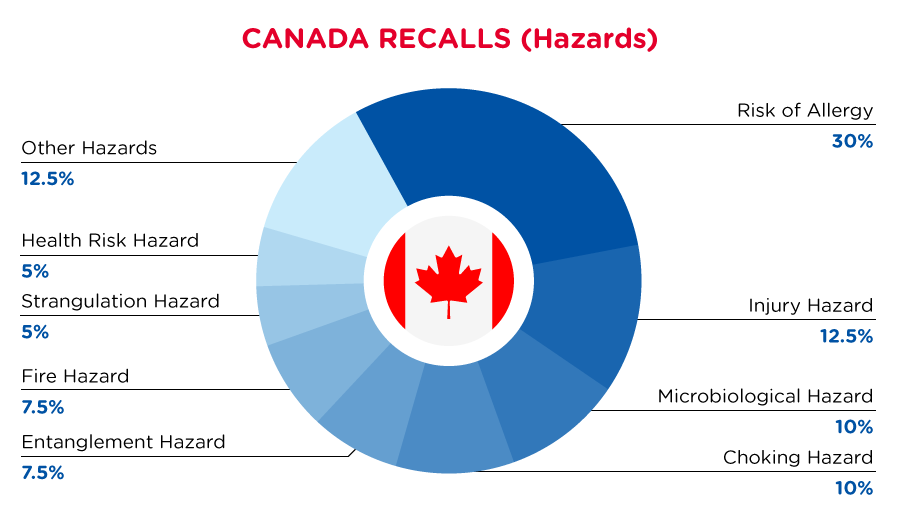
| Hazards | Frequency |
| Microbiological Hazard | 4 |
| Injury Hazard | 5 |
| Strangulation Hazard | 2 |
| Choking Hazard | 4 |
| Entanglement Hazard | 3 |
| Risk of Allergy | 12 |
| Fire Hazard | 3 |
| Health Risk Hazard | 2 |
| Other Hazards* | 5 |
*Other Hazards include Tip-Over Hazard, Laceration Hazard, Burn Hazard, Aspiration Hazard and Chemical Hazard with a frequency of less than 2.
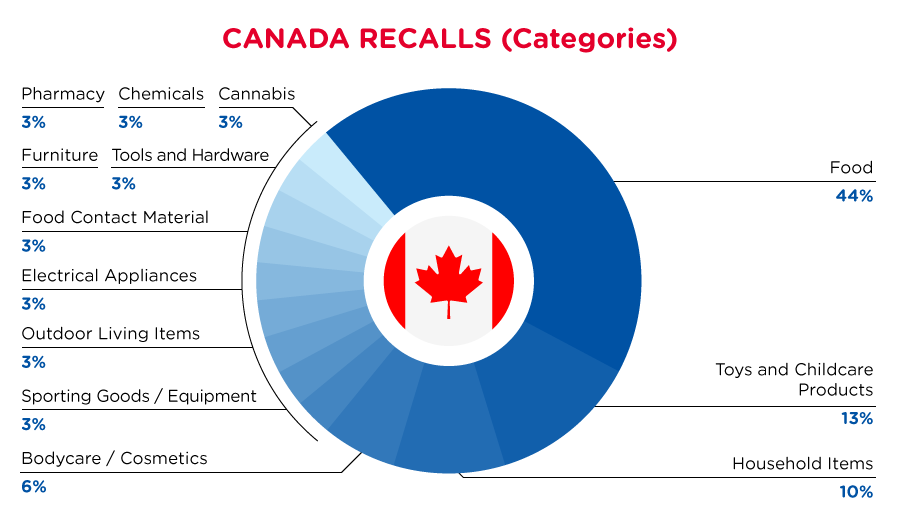
| Product Categories | Frequency |
| Food | 14 |
| Food Contact Material | 1 |
| Household Items | 3 |
| Toys and Childcare Products | 4 |
| Furniture | 1 |
| Bodycare / Cosmetics | 2 |
| Outdoor Living Items | 1 |
| Chemicals | 1 |
| Pharmacy | 1 |
| Cannabis | 1 |
| Electrical Appliances | 1 |
| Sporting Goods / Equipment | 1 |
| Tools and Hardware | 1 |
For a complete list click here
In the US, when hazards are identified in consumer products, they will be recalled and published in the Consumer Product Safety Commission (CPSC) Recent Recalls on the CPSC website, which is updated daily. The US recalls from 01 July 2022 to 31 July 2022 are summarized below:
View Story Read More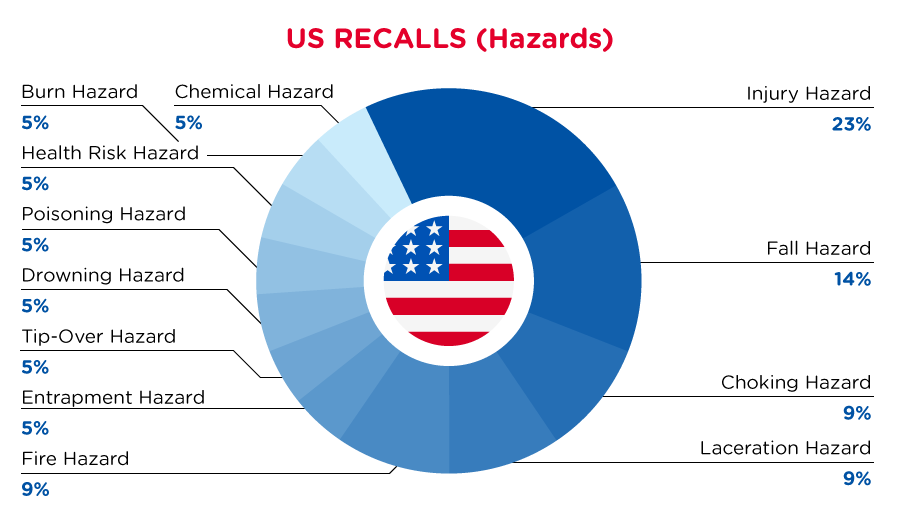
| Hazards | Frequency |
| Choking Hazard | 2 |
| Fall Hazard | 3 |
| Entrapment Hazard | 1 |
| Tip-Over Hazard | 1 |
| Injury Hazard | 5 |
| Drowning Hazard | 1 |
| Laceration Hazard | 2 |
| Poisoning Hazard | 1 |
| Fire Hazard | 2 |
| Burn Hazard | 1 |
| Chemical Hazard | 1 |
| Health Risk Hazard | 1 |
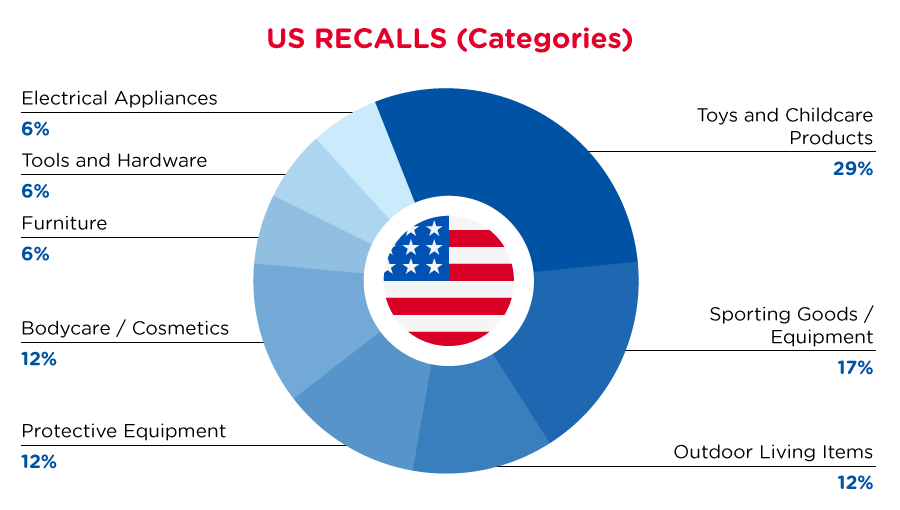
| Product Categories | Frequency |
| Toys and Childcare Products | 5 |
| Furniture | 1 |
| Outdoor Living Items | 2 |
| Protective Equipment | 2 |
| Sporting Goods / Equipment | 3 |
| Bodycare / Cosmetics | 2 |
| Tools and Hardware | 1 |
| Electrical Appliances | 1 |
For a complete list click here
In Australia, when hazards are identified in consumer products, they will be recalled and published in the Recalls and Safety Alerts Database on the Australian Competition & Consumer Commission website, which is updated daily. The Australia recalls from 01 July 2022 to 31 July 2022 are summarized below:
View Story Read More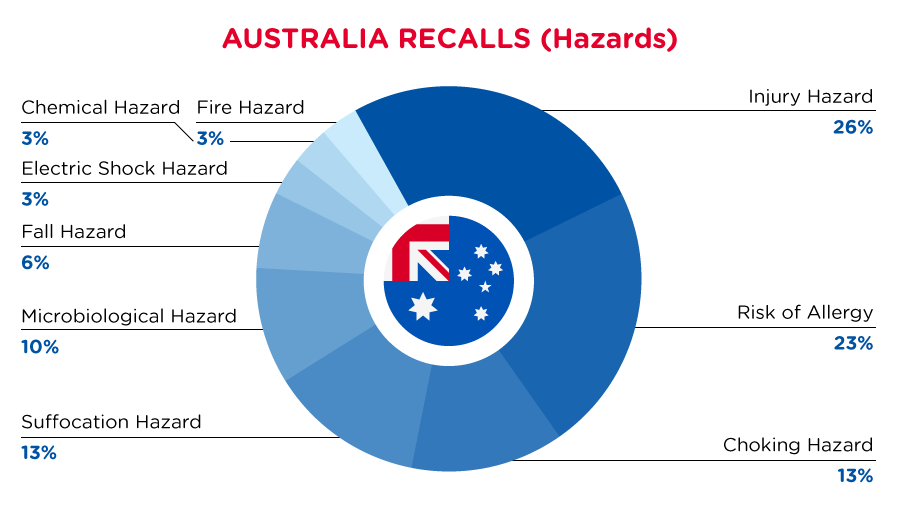
| Hazards | Frequency |
| Risk of Allergy | 7 |
| Injury Hazard | 8 |
| Microbiological Hazard | 3 |
| Chemical Hazard | 1 |
| Fire Hazard | 1 |
| Electric Shock Hazard | 1 |
| Choking Hazard | 4 |
| Suffocation Hazard | 4 |
| Fall Hazard | 2 |
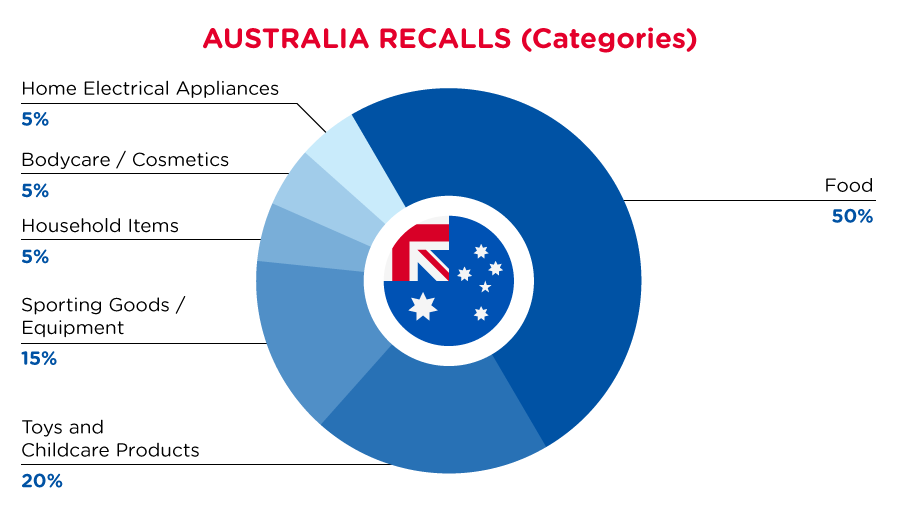
| Product Categories | Frequency |
| Food | 10 |
| Sporting Goods / Equipment | 3 |
| Bodycare / Cosmetics | 1 |
| Home Electrical Appliances | 1 |
| Toys and Childcare Products | 4 |
| Household Items | 1 |
For a complete list click here
The Department for Business, Energy & Industrial Strategy Notice of Publication 0061/22 of 9 August 2022 refers to standards listed in Annex I of notice 0061/22 which are amendments for Annex I of notice 0058/22 and references to standards listed in Annex II of notice 0061/22 which are amendments for Annex II of notice 0058/22.
View Story Read MoreThe Department for Business, Energy & Industrial Strategy Notice of Publication 0061/22 of 9 August 2022 references the following:
-
Part 1 of Annex I to this notice lists additional standards as an amendment for Annex 1 to notice 0588/22, such as EN IEC 60320-2-4: 2021, EN 60335-1:2012/A15:2021, EN 60335-2-5: 2015 / A1: 2020, EN 60335-2-17: 2013/A2: 2021, EN 60335-2-21: 2021, EN IEC 60335-2-43:2020/A11:2020, EN60335-2-73: 2003/A11:2021 and so on.
Part 2 of Annex I to this notice sets out the complete list of standards in support to regulation 2A of S.I. 2016/1101.
Annex I came into effect on 9 August 2022.
-
Part 1 of Annex II to this notice lists additional standards which will be removed from the notice 0058/22 publication. This is in addition to those previously listed from the dates set out in the table in the notice. These standards will not be valid on or after the date set out in respect of it, such as EN 60335-2-43: 2003+A1:2006+A2:2008, EN 60320-2-4:2016+A1:2009, EN 60598-2-23:1996+A1:2000, EN60335-1: 2012+A11:2014+A13:2017+A1: 2019+A14: 2019+A2:2019, EN 60335-2-5: 2015+A11:2019, EN 60335-2-17:2013+A11:2019+A1:2020 and so on.
Part 2 of Annex II to this notice sets out the complete list of standards which will be removed from publication.
The European Commission and its Scientific Committee on Health, Environmental and Emerging Risks published a preliminary opinion on the safety of cobalt in toys. The public consultation period ended on 18 August 2022.
View Story Read MoreIn 2020, there was an opinion request regarding safety of cobalt in toys from the European Commission that the Scientific Committee on Health, Environmental and Emerging Risks (SCHEER) evaluate the assessment from the Toys Industries of Europe (TIE) as well as information retrieved from a literature search, and perform the risk assessment for inhalation, oral and dermal exposure.
On 22 July 2022, the European Commission and its SCHEER published a preliminary opinion on the safety of the presence of cobalt in toys. It was under a public consultation period until 18 August 2022. Cobalt is classified as carcinogenic category 1B, mutagenic category 2 and toxic for reproduction category 1B. It is present in toys as an impurity in nickel and nickel-containing alloys or as being intentionally added in certain circumstances. The focus is on risks related to the carcinogenic properties of cobalt.
Based on the available information, the SCHEER considers the following scenarios as relevant for the exposure assessment:
- Cobalt-containing metals included to allow conduction of electric current;
- Cobalt-containing metals that serve a function other than electrical conductance such as for toys of metal, inexpensive jewelry for children, fidget spinners and magnets;
- Children’s make-up;
- 3D pens, materials for toy printers and printed toys;
- Cobalt-containing paintings, inks and coatings used for toys and toys made of leather or textiles;
- Toys containing batteries.
Inhalation
Risks due to cobalt inhalation associated with the use of cobalt-containing metals can be considered negligible. Potential risks can be associated with inhalation exposure to cobalt from powder-like toy materials such as children’s cosmetics or creative art toys containing cobalt-base pigments or colorants. For such toys, cobalt-free pigments should be used. Specific attention should be given to the ‘emerging’ use of cobalt-containing materials in 3D pens and 3D printers.
Oral Exposure
Based on available toxicological reference values, the SCHEER calculated new migration limits for cobalt in toys, in relation to oral exposure. However, the SCHEER acknowledged the uncertainties regarding the carcinogenic properties of cobalt after oral exposure; it is recommended to reduce the migration limits to the lowest technically achievable levels in the Toy Safety Directive (TSD).
| Migration Limit Value | Category 1 (Dry, brittle, powder-like or pliable toy materials) |
Category 2 (Liquid or sticky toy materials) |
Category 3 (Scraped-off toy materials) |
| Current Limit | 10.5 mg/kg | 2.6 mg/kg | 130 mg/kg |
| SCHEER's Opinion | 0.12 mg/kg | 0.03 mg/kg | 1.5 mg/kg |
Dermal Exposure
Dermal exposure is considered possible from metal toys, inexpensive children’s jewelry, children’s cosmetics, materials with cobalt-containing coatings or batteries, as well as from materials for 3D pens or printings. Due to the low migration of cobalt to artificial sweat and the very limited dermal absorption, the risk after dermal exposure is considered to be low or negligible by the SCHEER. The proposed REACH restriction on cobalt content in textiles (70 mg/kg) and leather (20 mg/kg) can be assumed to also protect children from sensitization from all toy materials that are in contact with the skin.
In Europe, when hazards are identified in non-food consumer products, the products will be recalled and published in the Safety Gate system, which is updated weekly. The European recalls from 01 July 2022 to 31 July 2022 are summarized below:
View Story Read More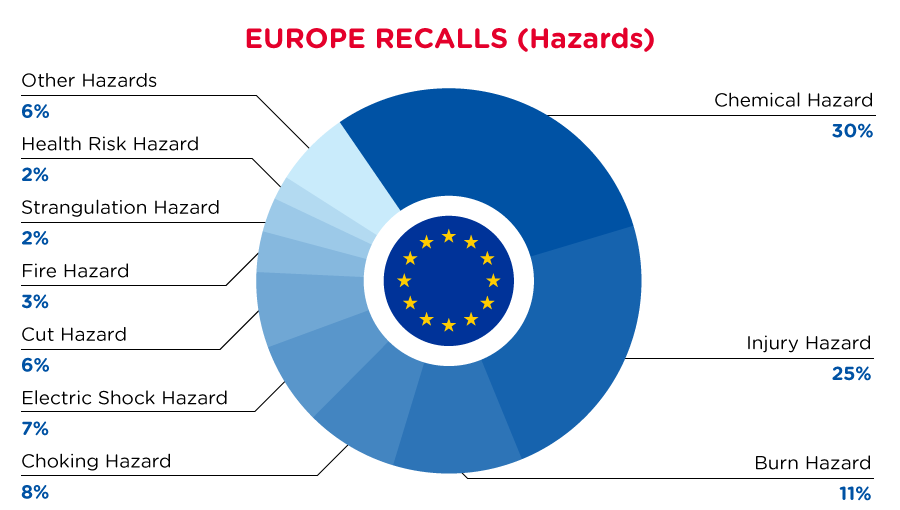
| Hazards | Frequency |
| Chemical Hazard | 61 |
| Electric Shock Hazard | 14 |
| Fire Hazard | 7 |
| Health Risk Hazard | 4 |
| Injury Hazard | 48 |
| Cut Hazard | 13 |
| Strangulation Hazard | 6 |
| Burn Hazard | 22 |
| Choking Hazard | 16 |
| Other Hazards* | 13 |
*Other Hazards include Asphyxiation Hazard, Suffocation Hazard, Damage to Sight, Environmental Hazard, Drowning Hazard and Microbiological Hazard with a frequency of less than 4.
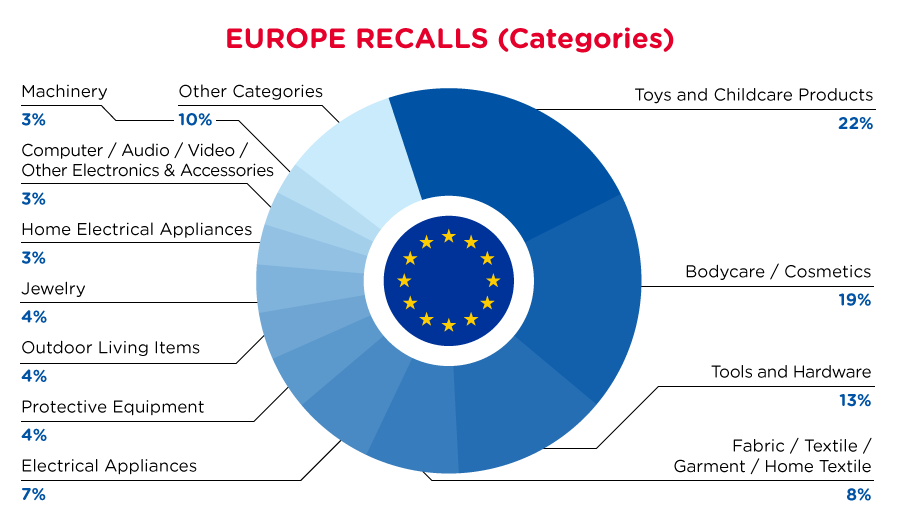
| Product Categories | Frequency |
| Bodycare / Cosmetics | 33 |
| Electrical Appliances | 12 |
| Protective Equipment | 8 |
| Tools and Hardware | 23 |
| Toys and Childcare Products | 40 |
| Fabric / Textile / Garment / Home Textile | 14 |
| Computer / Audio / Video / Other Electronics & Accessories | 6 |
| Home Electrical Appliances | 5 |
| Jewelry | 7 |
| Outdoor Living Items | 7 |
| Machinery | 5 |
| Other Categories* | 17 |
*Other Categories include Furniture, Sporting Goods / Equipment, Food Contact Material, Household Items, Footwear, Accessories and Chemicals with a frequency of less than 5.

| Notifying Country | Frequency |
| Lithuania | 22 |
| Germany | 46 |
| Belgium | 5 |
| Luxembourg | 4 |
| Poland | 16 |
| France | 9 |
| Latvia | 7 |
| Hungary | 7 |
| Czechia | 7 |
| Finland | 6 |
| Slovakia | 4 |
| Denmark | 6 |
| Cyprus | 12 |
| Bulgaria | 4 |
| Austria | 4 |
| Other Countries* | 18 |
*Other Countries include Estonia, Sweden, Romania, Iceland, Ireland, Italy, The Netherlands and Slovenia with a frequency of less than 4.
For a complete list click here
The Standardization Administration of China has issued a national standard for Professional Sportswear – Track and Field Garment (GB/T 41174-2021). It was included in China’s No. 17 announcement of approved national standards in 2021 and became effective on 1 July 2022.
View Story Read MoreThe National Standard for Professional Sportswear – Track and Field Garment (GB/T 41174-2021), is applicable to track and field garments for professional sports and was included in China’s No. 17 announcement of approved national standards in 2021. The effective date of this standard was 1 July 2022. It is applicable to track and field garments for adults and for children aged >36 months.
Other non-track and field garments can also refer to this standard.
Requirements: Products must comply with appearance quality and the internal quality stated in this standard. Internal quality includes:
- Fiber content
- Formaldehyde, Azo dyes
- pH value
- Odor
- Residual metal needle
- Color fastness (to washing, to rubbing, to perspiration, to water, to light, to light and perspiration, to transfer in joints)
- Dimensional change after washing, appearance after washing
- Pilling resistance
- Stretch & Recovery
- Strength performance (tear strength, seam slippage, seam strength of trouser back crotch seam, ball bursting strength)
- Functional tests (absorption, quick drying)
Children's products shall comply with the requirements in standard GB 31701, covering Infant and Children’s Textile Products.
In China, when hazards are identified in consumer products, they will be recalled and published in the SAMR Defective Product Administrative Centre, which is updated daily. The China recalls from 01 July 2022 to 31 July 2022 are summarized below:
View Story Read More
| Hazards | Frequency |
| Entanglement Hazard | 4 |
| Health Risk Hazard | 9 |
| Fall Hazard | 5 |
| Cut Hazard | 4 |
| Safety Risk Hazard | 12 |
| Injury Hazard | 3 |
| Electric Shock Hazard | 11 |
| Fire Hazard | 9 |
| Burn Hazard | 9 |
| Other Hazards* | 5 |
*Other Hazards include Swallowing Risk, Suffocation Hazard, Strangulation Hazard and Skin Irritation Risk with a frequency of less than 3.

| Product Categories | Frequency |
| Fabric / Textile / Garment / Home Textile | 9 |
| Stationery | 5 |
| Electrical Appliances | 8 |
| Protective Equipment | 2 |
| Sporting Goods / Equipment | 2 |
| Food Contact Material | 2 |
| Footwear | 2 |
| Bodycare / Cosmetics | 2 |
| Other Categories* | 6 |
*Other Categories include Furniture, Tools and Hardware, Toys and Childcare Products, Construction Products, Computer / Audio / Video / Other Electronics & Accessories and Home Electrical Appliances with a frequency of less than 2.

| Provinces | Frequency |
| Shanghai | 4 |
| Inner Mongolia | 4 |
| Jiangxi | 1 |
| Guangdong | 11 |
| Sichuan | 3 |
| Hubei | 2 |
| Hunan | 2 |
| Jilin | 1 |
| Jiangsu | 3 |
| Guangxi | 1 |
| Fujian | 5 |
| Shenzhen | 1 |
For a complete list click here

